What is weightlessness
We live at a time when the flights of spacecraft around the Earth, to the Moon and to other planets solar system are no longer surprising. We know that during the flight, cosmonauts and all objects on spaceships are in a special state called the state of weightlessness. What is this state and can it be observed on Earth? Weightlessness is complex physical phenomenon. In order to understand it, you need to remember something from the course of physics.
So, by the weight of a body, we mean the force with which the body, due to attraction to the Earth, presses on the support.
And imagine that the support and the body fall freely. After all, the support is also a body on which the force of gravity acts. What will be the weight of the body in this case: with what force will the body act on the support?
Let's do an experiment. Let's take a small body and hang it from a spring attached to a fixed support. Under the influence of gravity, the body begins to move downward, so the spring is stretched until an elastic force arises in it, which balances the force of gravity. If you cut the thread holding the spring with the body, the spring with the body will fall. It can be seen that during the fall, the tension of the spring disappears, and it returns to its original size.
What happens? When a spring with a body falls, it remains unstretched. That is, the falling body does not act on the spring falling with it. In this case, the weight of the body is zero, but the body and the spring are falling, which means that the force of gravity still acts on them.
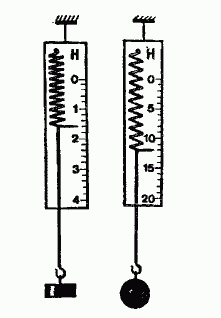 In the same way, if the body and the stand or support on which the body lies fall freely, then the body will no longer put pressure on the stand or support. In this case, the weight of the body will be zero.
In the same way, if the body and the stand or support on which the body lies fall freely, then the body will no longer put pressure on the stand or support. In this case, the weight of the body will be zero.
Similar phenomena are also observed on spacecraft and satellites. The satellite revolving around the Earth, the astronaut and all the bodies that are inside the satellite are in continuous free fall (they seem to fall to the Earth). As a result of this, the bodies, during the fall, do not put pressure on the support and do not stretch the spring. Such bodies are said to be in a state of weightlessness (“no weight”, weight is zero).
Bodies not fixed in the spacecraft “float” freely. The liquid poured into the vessel does not press on the bottom and walls of the vessel, so it does not flow out through the hole in the vessel. Clock pendulums rest in whatever position they are left in. An astronaut does not need any effort to keep an arm or leg in an extended position. He has no idea where is up and where is down. If a body is given a speed relative to the satellite cabin, then it will move in a straight line and uniformly until it collides with other bodies.
www.site, with full or partial copying of the material, a link to the source is required.
Presentation on the topic: The state of weightlessness


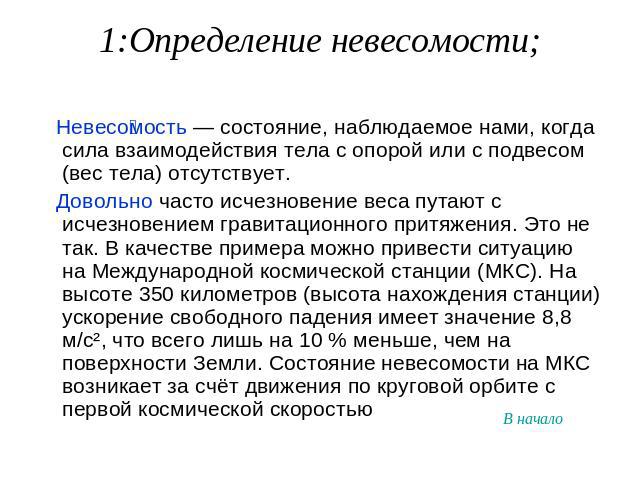
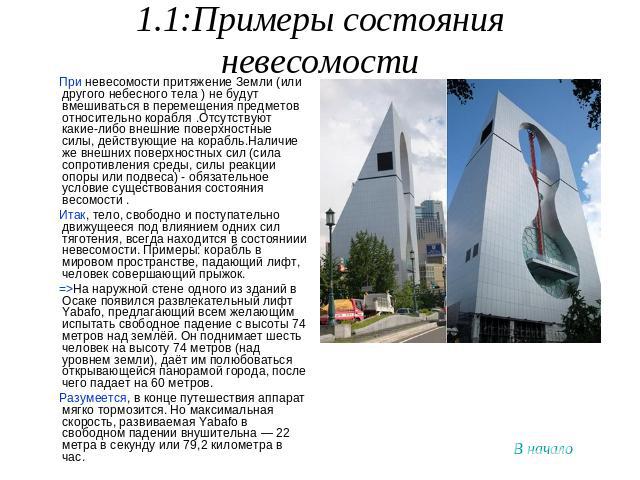

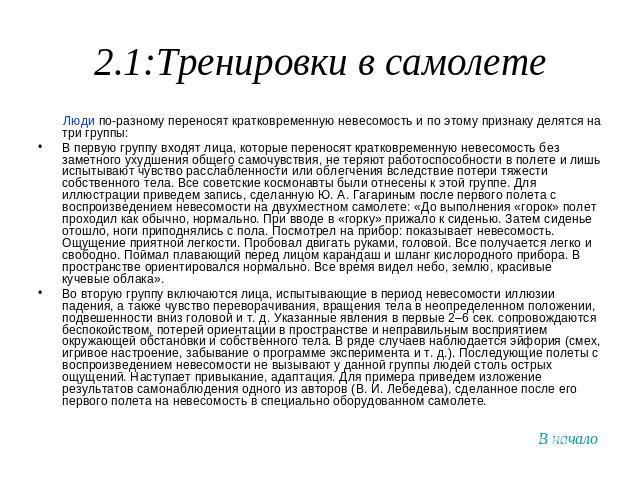


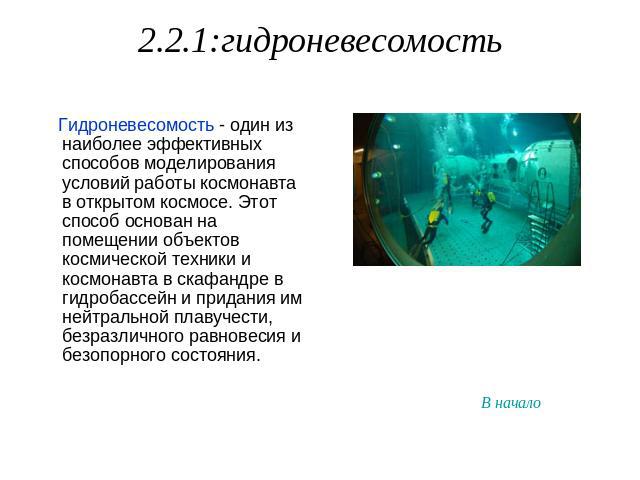

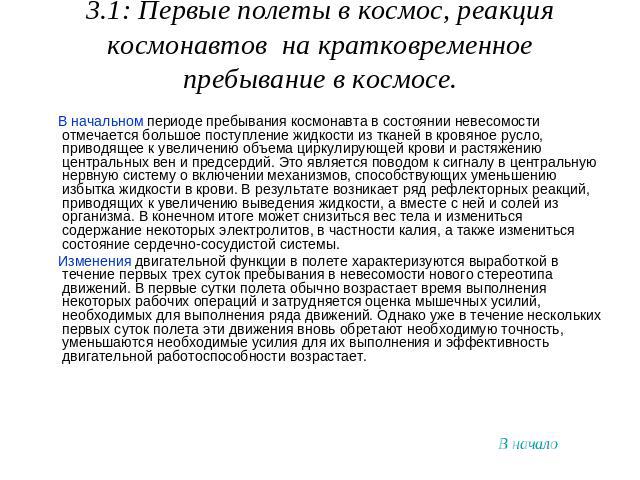






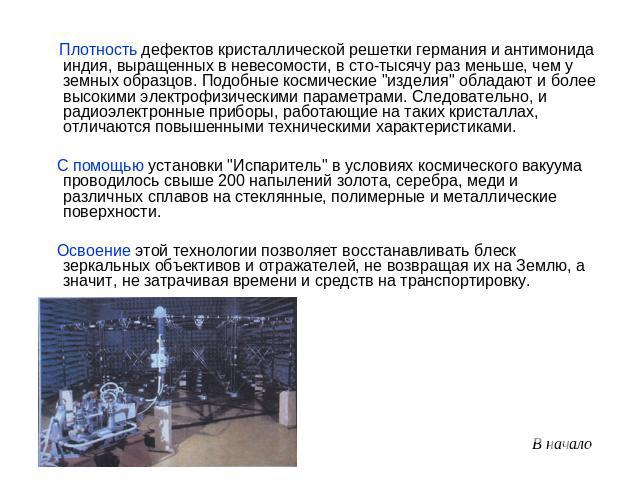





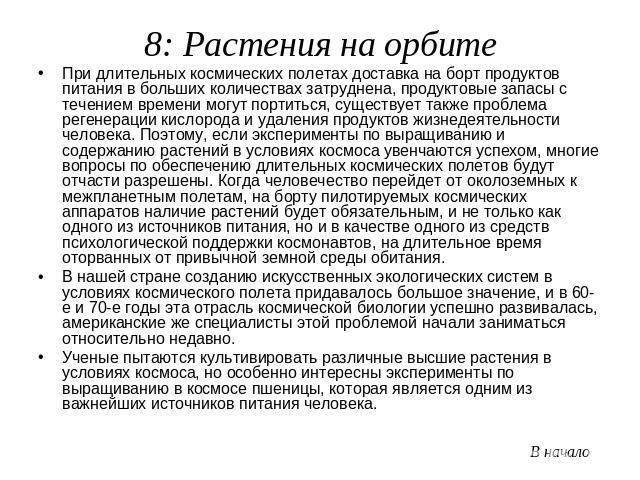


1 of 26
Presentation on the topic: State of weightlessness
slide number 1

Description of the slide:
slide number 2
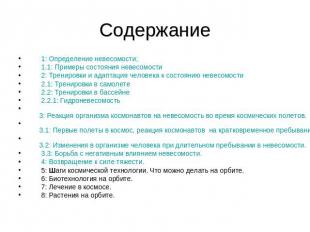
Description of the slide:
Content 1: Definition of weightlessness; 1.1: Examples of weightlessness 2: Human training and adaptation to weightlessness 2.1: Airplane training 2.2: Swimming pool training 2.2.1: Weightlessness 3: Cosmonauts' body response to weightlessness during space flights. 3.1: The first flights into space, the reaction of astronauts to a short stay in space. 3.2: Changes in the human body during prolonged exposure to weightlessness. 3.3: Fighting the negative effects of weightlessness. 4: Return to gravity. 5: Space technology steps. What can be done in orbit. 6: Biotechnology in orbit. 7: Treatment in space. 8: Plants in orbit.
slide number 3

Description of the slide:
1: The definition of weightlessness; Weightlessness is a state observed by us when the force of interaction of a body with a support or with a suspension (body weight) is absent. Quite often, the disappearance of weight is confused with the disappearance gravitational attraction. This is not true. An example is the situation on the International Space Station (ISS). At an altitude of 350 kilometers (station altitude), acceleration free fall has a value of 8.8 m / s², which is only 10% less than on the surface of the Earth. The state of weightlessness on the ISS arises due to movement in a circular orbit from the first space speed
slide number 4
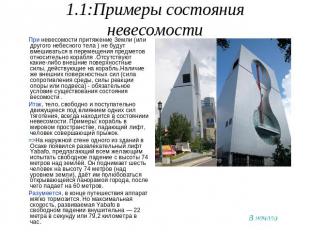
Description of the slide:
1.1: Examples of the state of weightlessness In weightlessness, the attraction of the Earth (or other celestial body) will not interfere with the movement of objects relative to the ship. There are no external surface forces acting on the ship. suspension) is a prerequisite for the existence of a state of weightiness. So, a body moving freely and progressively under the influence of gravity alone is always in a state of weightlessness. Examples: a ship in world space, a falling elevator, a person making a jump. => On the outer wall of a building in Osaka, the Yabafo entertainment elevator has appeared, offering everyone to experience a free fall from a height of 74 meters above the ground. He lifts six people to a height of 74 meters (above ground level), allows them to admire the opening panorama of the city, after which he falls 60 meters. Of course, at the end of the journey, the apparatus is gently braked. But the maximum speed developed by Yabafo in free fall is impressive - 22 meters per second or 79.2 kilometers per hour.
slide number 5

Description of the slide:
slide number 6

Description of the slide:
2.1: Training in an airplane People endure short-term weightlessness in different ways and are divided into three groups according to this criterion: loss of body weight. All Soviet cosmonauts were assigned to this group. To illustrate, let's take a note made by Yu. A. Gagarin after the first flight with the reproduction of weightlessness on a two-seater plane: “Before performing the slides, the flight proceeded as usual, normally. When entering the "slide" pressed against the seat. Then the seat moved away, legs lifted off the floor. I looked at the device: it shows weightlessness. Feeling of pleasant lightness. I tried to move my arms and head. Everything is easy and free. I caught a pencil and a hose of an oxygen device floating in front of my face. He was well oriented in space. All the time I saw the sky, the earth, beautiful cumulus clouds. The second group includes persons who during the period of weightlessness experience the illusion of falling, as well as a feeling of turning over, rotating the body in an indefinite position, hanging upside down, etc. These phenomena in the first 2-6 seconds. accompanied by anxiety, loss of orientation in space and a misperception of the environment and one's own body. In some cases, euphoria is observed (laughter, playful mood, forgetting about the experiment program, etc.). Subsequent flights with the reproduction of weightlessness do not cause such thrills in this group of people. Getting used to, adapting. As an example, let us cite the presentation of the results of self-observation by one of the authors (V. I. Lebedev) made after his first flight to weightlessness in a specially equipped aircraft.
slide number 7

Description of the slide:
The third group includes persons in whom spatial disorientation and illusions are more pronounced, continue throughout the entire period of weightlessness and are sometimes combined with the rapid development of symptoms of seasickness. In some representatives of this group, the illusion of falling reaches an extreme degree, accompanied by a feeling of horror, an involuntary cry and a sharp increase in motor activity. At the same time, there is complete disorientation in space and loss of contact with other people.
slide number 8
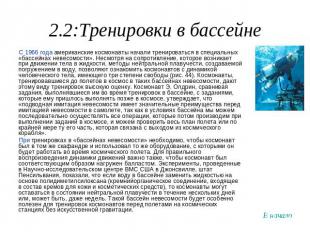
Description of the slide:
2.2: Swimming pool training Since 1966, American astronauts have been training in special "zero gravity pools". Despite the resistance that occurs when a body moves in a liquid, the methods of neutral buoyancy created by immersion in water make it possible to familiarize astronauts with the dynamics human body, which has three degrees of freedom (Fig. 44). Cosmonauts who have trained in such weightless pools prior to space flights give this type of training a high rating. Cosmonaut E. Aldrin, comparing the tasks he performed during training in the pool with the tasks that he had to perform later in space, claims that “an underwater simulation of weightlessness has significant advantages over the simulation of weightlessness in an airplane, since in a pool we can sequentially carry out all the operations that we then perform when performing tasks in space, and we can check the entire flight plan, or at least that part of it that is associated with the exit from spaceship". When training in "zero gravity pools", it is necessary that the astronaut be in the same space suit and use the same equipment with which he will work during the space flight. For the correct reproduction of the dynamics of movements, it is also important that the astronaut be properly loaded with ballast. Experiments conducted at the US Naval Research Center in Jonesville, Pennsylvania have shown that if pool water is replaced with a liquid based on polydimethylsiloxane (an organosilicon compound found in skin creams and cosmetics), astronauts can remain in a neutral state. buoyancy for days or maybe even weeks. Such a weightlessness pool will be especially useful for training astronauts before flights on space stations without artificial gravity.
slide number 9

Description of the slide:
2.2.1: Weightlessness Weightlessness is one of the most effective ways simulation of the working conditions of an astronaut in open space. This method is based on placing objects of space technology and an astronaut in a space suit in a hydro pool and imparting neutral buoyancy, indifferent balance and unsupported state to them.
slide number 10
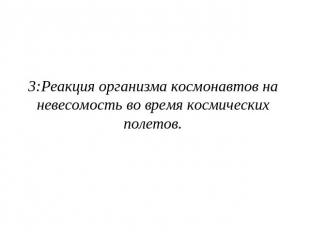
Description of the slide:
slide number 11
![]()
Description of the slide:
3.1: The first flights into space, the reaction of astronauts to a short stay in space. In the initial period of the astronaut's stay in a state of weightlessness, a large flow of fluid from the tissues into the bloodstream is noted, leading to an increase in the volume of circulating blood and stretching of the central veins and atria. This is the reason for the signal to the central nervous system on the inclusion of mechanisms that contribute to the reduction of excess fluid in the blood. As a result, a number of reflex reactions occur, leading to an increase in the excretion of fluid, and with it, salts from the body. Ultimately, body weight may decrease and the content of some electrolytes, in particular potassium, may change, as well as the state of the cardiovascular system. Changes in the motor function in flight are characterized by the development during the first three days of stay in weightlessness of a new stereotype of movements. On the first day of the flight, the time for performing some work operations usually increases and it becomes difficult to assess the muscle efforts required to perform a number of movements. However, already during the first few days of flight, these movements regain the necessary accuracy, the necessary efforts to perform them decrease, and the efficiency of motor performance increases.
slide number 12
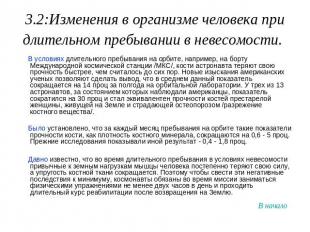
Description of the slide:
3.2: Changes in the human body during prolonged exposure to weightlessness. Under conditions of prolonged stay in orbit, for example, aboard the International Space Station /ISS/, the astronaut's bones lose their strength faster than previously thought. New research by American scientists allows us to conclude that, on average, this indicator is reduced by 14 percent in half a year at the orbital laboratory. Three of the 13 astronauts monitored by the Americans had a 30% reduction in the bone strength equivalent to that of an elderly woman living on Earth suffering from osteoporosis (bone thinning). It was found that for each month in orbit, indicators of bone strength, such as bone mineral density, are reduced by 0.6 to 5 percent. Previous studies showed a different result - 0.4 - 1.8 percent. It has long been known that during a long stay in weightlessness, human muscles, accustomed to earthly loads, gradually lose their strength, and the elasticity of bone tissue decreases. Therefore, in order to minimize these negative consequences, astronauts are required to exercise at least two hours a day during the mission and undergo a long rehabilitation course after returning to Earth.
slide number 13

Description of the slide:
3.3: Fighting the negative effects of weightlessness. Numerous methods for preventing the adverse effects of weightlessness, not related to the use of ICT, were tested in the course of the research. These include, for example, physical methods aimed at reducing the redistribution of blood in the astronaut's body during or after the end of the flight, as well as at stimulating the neuroreflex mechanisms that regulate blood circulation in the vertical position of the body. For this purpose, the application of negative pressure to the lower body, inflatable cuffs applied to the arms and legs, suits for creating a positive pressure difference, rotation on a small radius centrifuge, inertial impact effects, electrical stimulation of the muscles of the lower extremities, elastic and anti-g suits, etc. . Among other methods of such prevention, we note physical activity aimed at maintaining the fitness of the body and stimulating certain groups of receptors (physical training, load suits, load on the skeleton); effects associated with the regulation of nutrition (adding salts, proteins and vitamins to food, rationing nutrition and water consumption) Preventive agents against any adverse changes in the cosmonaut's body can be effective only if they are prescribed taking into account the mechanism of these disorders. With regard to weightlessness, prophylactic measures should be aimed primarily at replenishing the deficiency of muscle activity, as well as at reproducing the effects that, under Earth conditions, are determined by the weight of blood and tissue fluid.
slide number 14
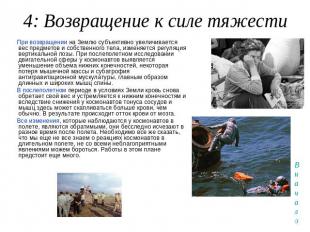
Description of the slide:
4: Return to gravity When returning to Earth, the weight of objects and one's own body subjectively increases, and the regulation of vertical posture changes. A post-flight study of the motor sphere in cosmonauts reveals a decrease in the volume of the lower extremities, some loss of muscle mass, and subatrophy of the anti-gravitational muscles, mainly the long and wide muscles of the back. In the post-flight period, under Earth conditions, blood regains its weight and rushes to the lower extremities, and as a result of a decrease in the tone of blood vessels and muscles in astronauts, more blood can accumulate here than usual. As a result, there is an outflow of blood from the brain. All changes that are observed in astronauts in flight are reversible, they disappear without a trace in different time after the flight. Nevertheless, it must be said that we still do not know everything about the reactions of astronauts in a long flight, we cannot fight against all adverse phenomena. There is still a lot of work to be done in this regard.
slide number 15
![]()
Description of the slide:
5: Space technology steps. What can be done in orbit. Here and in the United States, technological activity in weightlessness has acquired such a scope that, in its diversity, it has approached technology in the broadest sense of the word, mastered in terrestrial practice. Today, in the real conditions of space flight, not only are semiconductor crystals grown, glass is melted, alloys are made, but assembly and installation, maintenance and repair work is carried out, coatings are sprayed, materials, assemblies, and equipment are tested. The results obtained on board the Soviet manned and automatic vehicles are aimed at meeting the scientific and economic needs of man. However, they also influence the shape and technical level the products of space engineering. It cannot be said that all properties of the space environment attract the attention of technologists. The first place is occupied by the sun's rays. Converted to electricity, they power all on-board systems, including crystal growth ovens, vacuum surface deposition equipment. But of the other cosmic "benefits" so far only weightlessness has been "involved". Occasionally space vacuum finds application. The rest of the properties have not yet come the turn. Space technology was born only in 1969. On the Soyuz-6 spacecraft, Valery Kubasov welded parts with a plasma arc low pressure and consumable electrode, cut metal with an electron beam. Then, for the first time in space flight, the main metallurgical processes were experimentally verified - the melting of materials, the molding of liquid masses, their cooling and crystallization. It has been practically proved that technological operations can be performed in zero gravity and in vacuum. At the same time, it turned out that they flow there differently than on Earth, since in orbit the decisive role is played by the forces surface tension, diffusion, capillary effects and other intermolecular interactions.
slide number 16
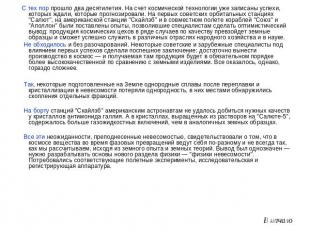
Description of the slide:
Two decades have passed since then. At the expense of space technology, the successes that were expected and predicted have already been recorded. At the first Soviet Salyut orbital stations, at the American Skylab station and in the joint flight of the Soyuz and Apollo spacecraft, experiments were carried out that allowed specialists to draw an optimistic conclusion: the products of space workshops in some cases will surpass terrestrial samples in quality and will be able to serve successfully in various industries National economy and in science. It was not without disappointment. Some Soviet and foreign experts, under the influence of the first successes, made a hasty conclusion: it is enough to take production into space - and the products obtained there will necessarily be of a higher quality than terrestrial products. Everything turned out, however, much more complicated. Thus, after remelting and crystallization in zero gravity, some homogeneous alloys prepared on Earth lost their homogeneity, and accumulations of individual fractions were found in them in places. On board the Skylab stations, American astronauts failed to achieve the desired qualities in gallium antimonide crystals. And the crystals grown from solutions at Salyut-5 contained more gas-liquid inclusions than similar terrestrial samples. All these surprises, presented by weightlessness, testified to the fact that in space, substances during phase transformations behave differently and not always in the way we expect, based on earthly experience and earthly theories. The conclusion was unequivocal - it is necessary to develop the foundations of a new branch of physics - "weightlessness physics". Appropriate flight experiments, research and recording equipment were required.
slide number 17

Description of the slide:
In the two decades since the first liquid masses of metal solidified in space and grown crystals, we have come close to a well-established industrial production semiconductors and optical glasses, homogeneous alloys, pure drugs and vaccines. In general, the Salyut-6 crews at the Kristall and Splav technological installations carried out almost 200 melts, made about 300 samples of semiconductor materials, alloys, glasses, more than 50 of them - according to international methods. For the first time in practice, relatively large three-component crystals of MCT were grown, a compound consisting of atoms of cadmium, mercury, and tellurium. Under terrestrial conditions, it is not possible to obtain such large specimens due to the rapid stratification of the melt. MCT crystals are used in receivers of infrared (thermal) radiation. The range of "vision" of these receivers is very wide - from 1 to 30 microns. A number of other crystals were also grown, surpassing their terrestrial counterparts in their properties. More orderly internal structure, purity, big sizes- these are the features of space products. That's what it means to "turn off from the game" such a powerful force as the earth's gravity.
slide number 18
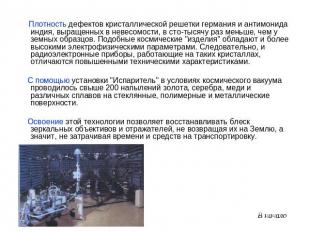
Description of the slide:
The density of defects in the crystal lattice of germanium and indium antimonide grown in weightlessness is a hundred to a thousand times less than that of terrestrial samples. Such space "products" also have higher electrical parameters. Consequently, radio-electronic devices operating on such crystals are distinguished by increased technical characteristics. Using the "Evaporator" installation under conditions space vacuum more than 200 sputterings of gold, silver, copper and various alloys were carried out on glass, polymer and metal surfaces. The development of this technology makes it possible to restore the brilliance of mirror lenses and reflectors without returning them to Earth, which means without spending time and money on transportation.
Description of the slide:
6: Biotechnology in orbit. Only the Russian part of the scientific program of the 20th expedition included 42 different experiments, five of which have not yet been carried out on the ISS. The cosmonauts brought to Earth samples and cassettes with the results of experiments carried out on board, as well as a bioreactor with substrates obtained in zero gravity. They were received in orbit by the ISS-20 crew changer, Maxim Suraev, and Padalka and Barratt delivered the bioreactor back. The "Bioemulsion" experiment on the cultivation of bacterial cultures and mycorrhizal fungi was held on the ISS during the crew change for the seventh time, moreover, for the first time, scientists conducted a new "Cascade" experiment in the bioreactor. In addition, the cosmonauts brought eight test tubes with "space centenarians" - cell strains of ginseng and yew, which traveled to the ISS for two months. For yew cells, this was the second orbital journey, for ginseng - the third. According to Tatyana Krasheninnikova, head of the Ginseng-2 experiment, the studies showed that "after exposure to space flight factors, the productivity of ginseng cells became 20-30 percent higher than in the control group on Earth." With a new flight, the scientists wanted to “fix these properties in order to obtain a more effective cell line”, from which it will later be possible to produce new miracle drugs that save humanity from many serious diseases, including cancer. AT last years such a new direction of research as space biotechnology began to develop rapidly, the main task of which is to develop methods for obtaining ultra-pure drugs and biologically active substances (hormones, vitamins, enzymes) in zero gravity. Despite the short period of existence, space biology and space medicine have taken a strong position among other biomedical sciences. This is due to the rapid pace of development of these areas, the novelty of the tasks being solved and the impressive achievements that attract the attention of specialists and the general scientific community. A large amount of accumulated knowledge about the vital activity of an organism under the influence of outer space factors, dynamic factors of flight and artificial habitat, as well as the achievements of space technology are real prerequisites for the intensive exploration of outer space in the 21st century.
slide number 21

Description of the slide:
7: Treatment in space. Contrary to the stereotype that people with good health go into space, everything happened. Of course, before the flight, the astronaut must be as healthy as possible, but ... the reaction of the body to weightlessness and flight under such physical and psychological stress is unpredictable. If one of the crew members falls ill in orbit, there are two options - either stop the flight or treat it remotely, from the Earth. I recently published some anonymous astronaut stories about how serious enough illnesses were "hushed up" so that the flight was not interrupted. Negotiations between crew members and doctors are carried out over a closed communication line, in which signals are transmitted in coded form. These signals are decoded directly in the MCC - in strict secrecy. According to some analysts, doctors themselves may be interested in such secrecy so that they can hide their own mistakes - both in the selection of candidates for astronauts, and in their training, and especially in the treatment of their patients in flight. However, this is not the case, it's just that astronauts' illnesses are their own business. Flights were canceled due to illness of the crew members three times. The first, at the Salyut-7 orbital station in 1985. The commander - 33-year-old lieutenant colonel of the Air Force Vladimir Vasyutin, flight engineer Viktor Savinykh and cosmonaut-researcher Alexander Volkov were supposed to work in space for six months. But two months later, commander Vasyutin fell seriously ill. Since his health was rapidly deteriorating, and it was impossible to reduce the severity of the disease with the help of the medicines available on board, it was decided to immediately stop the flight. The crew returned to Earth not after six months, but after 65 days.
slide number 22

Description of the slide:
I had to interrupt the flight of Boris Volynov and Vitaly Zholobov, who began work on the Salyut-5 orbital station in July 1976. After some time, the astronauts felt a strange smell: there was a suspicion that during the ejection of the container with household waste outside through the airlock, vapors of poisonous heptyl penetrated into the living quarters of the star house. The crew's health deteriorated markedly. After another emergency happened in August - the lights went out, appliances, fans turned off, the station looked like a dead house and lost its orientation. The crew managed to return "Salyut-5" to the operating mode, but the strongest stress plus strange couples did not go unnoticed for Vitaly Zholobov: he began to have excruciating headaches, he lost his appetite, stopped sleeping, could not work. Then an order came from Earth: emergency landing! Instead of 60 days, the flight lasted 49. During the space flight, flight engineer Alexander Laveikin had abnormalities in the work of the heart. The flight engineer returned to Earth ahead of schedule ... In space, all diseases worsen unpredictably: in this regard, the crew is even trained to work with medical devices, such as a defibrillator. Some astronauts themselves inserted seals in orbit to replace those that had fallen out. It is always noisy at the stations: fans are constantly working, mixing the air, otherwise life-threatening stagnant zones with a high content of carbon dioxide exhaled by astronauts may form. As a result, both day and night, a strong hum does not stop: 80 - 95 decibels. Astronauts often have reduced hearing acuity, although the instructions prescribe wearing earplugs. Perhaps in the near future it will be possible to perform operations on astronauts in need of surgical intervention directly in orbit. And with the development of the era of space tourism, experts do not exclude the possibility of giving birth in zero gravity
slide number 23

Description of the slide:
slide number 24

Description of the slide:
Figure 8: Plants in orbit On long space missions, it is difficult to bring food in large quantities on board, food stocks can deteriorate over time, there is also the problem of regenerating oxygen and removing human waste products. Therefore, if experiments on the cultivation and maintenance of plants in outer space are crowned with success, many questions concerning the provision of long-term space flights will be partly resolved. When humanity moves from near-Earth to interplanetary flights, the presence of plants on board manned spacecraft will be mandatory, and not only as one of the sources of nutrition, but also as one of the means of psychological support for astronauts, cut off from their usual earthly habitat for a long time. In our country, the creation of artificial ecological systems in the conditions of space flight was given great importance, and in the 60s and 70s this branch of space biology developed successfully, while American specialists began to deal with this problem relatively recently. Scientists are trying to cultivate various higher plants in space, but experiments on growing wheat in space, which is one of the most important sources of human nutrition, are especially interesting.
Candle burning on Earth (left) and in zero gravity (right)
Weightlessness- a state in which the force of interaction of the body with the support (body weight), arising due to gravitational attraction, is negligible. Sometimes you can hear another name for this effect - microgravity.
Features of human activity and the work of technology
Weightless on board spacecraft many physical processes(convection, combustion, etc.) proceed differently than on Earth. The absence of gravity, in particular, requires special design of systems such as showers, toilets, food heating systems, ventilation, etc. To avoid the formation of stagnant zones where carbon dioxide can accumulate, and to ensure an even mixing of warm and cold air, on The ISS, for example, has a large number of fans installed. Eating and drinking, personal hygiene, working with equipment and, in general, ordinary everyday activities also have their own characteristics and require the astronaut to develop habits and the necessary skills.
The influence of weightlessness is inevitably taken into account in the design of a liquid propellant rocket engine designed to be launched in weightlessness. Liquid fuel components in tanks behave exactly like any liquid (form liquid spheres). For this reason, the supply of liquid components from the tanks to the fuel lines may become impossible. To compensate for this effect, a special design of tanks is used (with separators for gas and liquid media), as well as a procedure for settling fuel before starting the engine. Such a procedure consists in turning on the auxiliary engines of the ship for acceleration; the slight acceleration created by them precipitates liquid fuel on the bottom of the tank, from where the supply system directs the fuel into the lines.
Impact on the human body
During the transition from the conditions of terrestrial gravity to the conditions of weightlessness (first of all, when the spacecraft enters orbit), most astronauts experience an organism reaction called space adaptation syndrome.
With a long (more than a week) stay of a person in space, the absence of gravity begins to cause certain changes in the body that are of a negative nature.
The first and most obvious consequence of weightlessness is the rapid atrophy of the muscles: the muscles are actually turned off from human activity, as a result, all the physical characteristics of the body fall. In addition, the consequence of a sharp decrease in the activity of muscle tissues is a reduction in the body's consumption of oxygen, and due to the resulting excess of hemoglobin, the activity of the bone marrow that synthesizes it (hemoglobin) may decrease.
There is also reason to believe that the restriction of mobility will disrupt the phosphorus metabolism in the bones, which will lead to a decrease in their strength.
Weight and gravity
Quite often, the disappearance of weight is confused with the disappearance of gravitational attraction. This is not true. An example is the situation on the International Space Station (ISS). At an altitude of 350 kilometers (the altitude of the station), the acceleration of gravity is 8.8 / ², which is only 10% less than on the surface of the Earth. The state of weightlessness on the ISS does not arise due to the “lack of gravity”, but due to movement in a circular orbit with the first cosmic velocity, that is, astronauts, as it were, constantly “fall forward” at a speed of 7.9 km / s.
Weightlessness on Earth
On Earth, for experimental purposes, a short-term state of weightlessness is created (up to 40 s) when an aircraft flies along a ballistic trajectory, that is, such a trajectory along which an aircraft would fly under the influence of force alone gravity. This trajectory is a parabola at low speeds, which is why it is sometimes erroneously called "parabolic"; in general, the trajectory is an ellipse or hyperbola.
Such methods are used to train astronauts in Russia and the United States. In the cockpit, a ball is suspended on a thread, which usually pulls the thread down (if the aircraft is at rest or moves uniformly and in a straight line). The absence of tension on the thread on which the ball hangs indicates weightlessness. Thus, the pilot must control the aircraft so that the balloon is suspended in the air, and the thread is not taut. To achieve this effect, the aircraft must have a constant downward acceleration g. In other words, pilots create zero G. For a long time such an overload (up to 40 seconds) can be created if you perform a special aerobatic maneuver "failure in the air." Pilots abruptly begin to climb, entering a "parabolic" trajectory, which ends with the same abrupt drop in altitude. Inside the fuselage there is a chamber in which future cosmonauts train, it has a special soft coating on the walls to avoid injuries both in moments of weightlessness and in moments of overload.
A person experiences a similar feeling of weightlessness when flying on civil aviation flights during landing. However, for the sake of flight safety and due to the heavy load on the aircraft structure, civil Aviation drops altitude, making several extended spiral turns (from a flight altitude of 11 km to an approach altitude of about 1-2 km). That is, the descent is made in several passes, during which the passenger feels for a few seconds that he is being lifted up from the seat. It's the same feeling experienced by motorists who are familiar with the steep hills when the car starts to move down from the top.
Allegations that an aircraft performs aerobatics such as "Nesterov's loop" to create short-term weightlessness are nothing more than a myth. Training is performed in slightly modified commercial passenger or cargo class vehicles, for which aerobatics and similar flight conditions are supercritical and can lead to destruction of the vehicle in the air or rapid fatigue failure of supporting structures.
The state of weightlessness can be felt at the initial moment of free fall of a body in the atmosphere, when the air resistance is still small.
There is no attraction, the action of other mass forces, in particular, the force of inertia arising from the accelerated movement of the body. Sometimes you can hear another name for this effect - microgravity. This name is incorrect for near-Earth flight. Gravity (the force of attraction) remains the same. But when flying over long distances from celestial bodies, when their gravitational influence is negligible, microgravity really arises.
To understand the essence of weightlessness, one can consider an aircraft flying along a ballistic trajectory. Such methods are used to train astronauts in Russia and the United States. In the cockpit, a weight is suspended on a thread, which usually pulls the thread down (if the aircraft is at rest or moves evenly and in a straight line). When the thread on which the ball hangs is not stretched, a state of weightlessness takes place. Thus, the pilot must control the aircraft so that the balloon is suspended in the air, and the thread is not taut. To achieve this effect, the aircraft must have a constant downward acceleration g. In other words, pilots create zero G. For a long time, such an overload (up to 40 seconds) can be created by performing a special aerobatics maneuver (which has no name other than "failure in the air"). Pilots abruptly apply for a decrease in altitude, with a standard flight altitude of 11,000 meters, this gives the required 40 seconds of "weightlessness"; inside the fuselage there is a chamber in which future cosmonauts train; it has a special soft coating on the walls to avoid injuries during climb and drop. A person experiences a similar feeling of weightlessness when flying civil aviation flights during landing. However, for the sake of flight safety and a heavy load on the aircraft structure, civil aviation drops altitude by making several long spiral turns (from a flight altitude of 11 km to an approach altitude of about 1-2 km). Those. the descent is made in several passes, during which the passenger feels for a few seconds that he is lifted up from the seat. (The same feeling is familiar to motorists who are familiar with tracks passing through steep hills when the car starts to move down from the top) Claims that the aircraft performs aerobatics such as "Nesterov's loop" to create short-term weightlessness is nothing more than a myth. Training is performed in slightly modified commercial passenger or cargo class vehicles, for which aerobatics and similar flight conditions are supercritical and can lead to destruction of the vehicle in the air or rapid fatigue failure of supporting structures.
Encyclopedic YouTube
Features of human activity and the work of technology in weightlessness
Under conditions of weightlessness on board a spacecraft, many physical processes (convection, combustion, etc.) proceed differently than on Earth. The absence of gravity, in particular, requires a special design of systems such as showers, toilets, food heating systems, ventilation, etc. To avoid the formation of stagnant zones where carbon dioxide can accumulate, and to ensure even mixing of warm and cold air, the ISS, for example, has a large number of fans installed. Eating and drinking, personal hygiene, working with equipment and, in general, ordinary everyday activities also have their own characteristics and require the astronaut to develop habits and the necessary skills.
The influence of weightlessness is inevitably taken into account in the design of a liquid-propellant rocket engine designed to be launched in zero gravity. Liquid fuel components in tanks behave exactly like any liquid (form liquid spheres). For this reason, the supply of liquid components from the tanks to the fuel lines may become impossible. To compensate for this effect, a special design of tanks is used (with separators for gas and liquid media), as well as a procedure for settling fuel before starting the engine. Such a procedure consists in turning on the auxiliary engines of the ship for acceleration; the slight acceleration created by them precipitates liquid fuel on the bottom of the tank, from where the supply system directs the fuel into the lines.
The impact of weightlessness on the human body
During the transition from the conditions of terrestrial gravity to the conditions of weightlessness (first of all, when the spacecraft enters orbit), the majority of astronauts experience an organism reaction called the space adaptation syndrome.
With a long (several weeks or more) stay of a person in space, the absence of gravity begins to cause certain changes in the body that are of a negative nature.
The first and most obvious consequence of weightlessness is the rapid atrophy of the muscles: the muscles are actually turned off from human activity, as a result, all the physical characteristics of the body fall. In addition, the consequence of a sharp decrease in the activity of muscle tissues is a reduction in the body's consumption of oxygen, and due to the resulting excess of hemoglobin, the activity of the bone marrow that synthesizes it (hemoglobin) may decrease.
There is also reason to believe that the restriction of mobility will disrupt the phosphorus metabolism in the bones, which will lead to a decrease in their strength.
Weight and gravity
Quite often, the disappearance of weight is confused with the disappearance of gravitational attraction. This is not true. An example is the situation at the International Space Station (ISS). At an altitude of 350 kilometers (the height of the station), the acceleration free fall has a value of 8.8
« Physics - Grade 10 "
Remember the definition of gravity. Can she disappear?
As we know, gravity is the force with which the Earth attracts a body located on its surface or near this surface.
body weight called the force with which this body acts on a horizontal support or stretches the suspension.
Weight is not a force of some specific nature. This name is given to a particular case of the manifestation of the force of elasticity.
The weight acts directly on the cup of the spring balance and stretches the spring; under the action of this force, the balance arm rotates.
Let us explain what has been said with a simple example.

Let body A be on a horizontal support B (Fig. 3.9), which can serve as a weighing pan.
We denote the force of gravity by , and the force of pressure of the body on the support (weight) - by 1 .
The modulus of the reaction force of the support is equal to the modulus of weight 1 according to Newton's third law.
The force is directed in the direction opposite to the weight 1
The reaction force of the support is applied not to the support, but to the body on it.
While gravity is due to the interaction of the body with the Earth, weight 1 appears as a result of a completely different interaction - the interaction of body A and support B.
Therefore, weight has features that significantly distinguish it from gravity.
The most important feature of the weight is that its value depends on the acceleration with which the support is moving.
When bodies are transferred from the pole to the equator, their weight changes, since due to the daily rotation of the Earth, the balance with the body has centripetal acceleration at the equator.
According to Newton's second law for a body located at the equator, we have
where N is the reaction force of the support, equal to the weight of the body.
At the pole body weight equal to strength gravity. Obviously, the weight of the body is greater at the pole than at the equator.
Let's take a simpler case.
Let the body be on a cup of spring balances in an elevator moving with acceleration .
According to Newton's second law
Let us direct the coordinate axis OY of the reference system associated with the Earth vertically downwards.
Let us write the equation of motion of the body in projection onto this axis:
ma y = F y + N y.
If the acceleration is directed downwards, then, expressing the projections of the vectors in terms of their modules, we obtain ma = F - N. Since N = F 1, then ma = F - F 1 .
From this it is clear that only at a = 0 the weight is equal to the force with which the body is attracted to the Earth (F 1 = F). If a ≠ 0, then F 1 \u003d F - ma \u003d m (g - a).
The weight of the body depends on the acceleration with which the support is moving, and the appearance of this acceleration is equivalent to a change in the acceleration of free fall.
If, for example, the elevator is made to fall freely, i.e., a = g, then F 1 = m(g - g) = 0, the body is in a state of weightlessness.
The onset of a state of weightlessness for bodies means that the bodies do not put pressure on the support and, therefore, the reaction force of the support does not act on them, they move only under the influence of the force of attraction to the Earth.
Is the nature of weightlessness the same for bodies in an elevator and for bodies in a satellite?
The mechanical essence of weightlessness lies in the fact that in a frame of reference moving relative to the Earth with free fall acceleration, all phenomena that are caused by gravity on Earth disappear.
Experiments were repeatedly carried out in which a state of weightlessness was created. For example, an airplane accelerates and, starting from a certain moment, moves strictly along a parabola, the one that would be in the absence of air.
At the same time, unusual phenomena are observed in the cockpit: the pendulum freezes in a deflected position, the water splashed out of the glass hangs in the air like a large spherical drop, and next to it all other objects freeze, as if suspended on invisible threads, regardless of their mass and shape.
The same thing happens in the cockpit of a spacecraft as it moves in orbit.
On the high altitude there is almost no air above the Earth, so it is not necessary to compensate for its resistance by the operation of the engines.
And the flight lasts not a minute, but many days.






